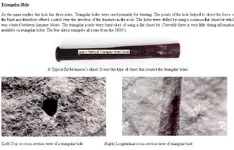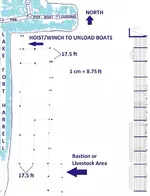Bronze was used in ancient Egypt. Here's a 1790 U.S. mention, likely iron.Plug and feather - Wikipedia, the free encyclopedia
You are using an out of date browser. It may not display this or other websites correctly.
You should upgrade or use an alternative browser.
You should upgrade or use an alternative browser.
Swamp Gold
- Thread starter Bigcypresshunter
- Start date
Bigcypresshunter
Sapphire Member
- Joined
- Dec 15, 2004
- Messages
- 27,000
- Reaction score
- 3,340
- Golden Thread
- 0
- Location
- South Florida
- Detector(s) used
- 70's Whites TM Amphibian, HH Pulse, Ace 250
- Primary Interest:
- Beach & Shallow Water Hunting
- #1,682
Thread Owner
Limestone should be easy going as it's softer than some other types. Harder than sandstone,soapstone and others though. Have to look at pic more but some poles to stretch a canvas tarp for shade would want guy ropes for tension on them to stakes/anchors.
Alright I was looking a Vor's pic of holes. Post mould holes in rectangle at fort site could be for walls sure. Those here much farther north had a ditch/trench inside near the wall with earth piled against wall and refuse in trench.Outside may have had ditch only with dirt brought inside?
Alright I was looking a Vor's pic of holes. Post mould holes in rectangle at fort site could be for walls sure. Those here much farther north had a ditch/trench inside near the wall with earth piled against wall and refuse in trench.Outside may have had ditch only with dirt brought inside?
Last edited:
Bigcypresshunter
Sapphire Member
- Joined
- Dec 15, 2004
- Messages
- 27,000
- Reaction score
- 3,340
- Golden Thread
- 0
- Location
- South Florida
- Detector(s) used
- 70's Whites TM Amphibian, HH Pulse, Ace 250
- Primary Interest:
- Beach & Shallow Water Hunting
- #1,685
Thread Owner
Yes I think they cleaned them out for the photos.What's your theory on why holes are not filled up after all these years?
Unless they cleaned them out for photos.
Even though the land is on high ground, the water level is just below the surface and may have helped erode the vegetation in the holes.
I was just wondering how soldiers could have cut these holes in such a remote location. There is not much more I can do as Im sure the NPS doesnt want anyone disturbing the area.
Last edited:
Bigcypresshunter
Sapphire Member
- Joined
- Dec 15, 2004
- Messages
- 27,000
- Reaction score
- 3,340
- Golden Thread
- 0
- Location
- South Florida
- Detector(s) used
- 70's Whites TM Amphibian, HH Pulse, Ace 250
- Primary Interest:
- Beach & Shallow Water Hunting
- #1,687
Thread Owner
I guess that would do it. I used to live in South Miami and our yard under the sod was rock. It was hell just to plant something.Prob pick aka San Angelo bar.
ECS
Banned
- Joined
- Mar 26, 2012
- Messages
- 11,638
- Reaction score
- 17,695
- Golden Thread
- 0
- Location
- Ocala,Florida
- Primary Interest:
- Other
The US army during that time period used star drills where were struck with a sledge hammer,then squared off using other stone chisels.Yes,it was hard work.
I have several of those in my collection,passed down through the family.
I have several of those in my collection,passed down through the family.
Bigcypresshunter
Sapphire Member
- Joined
- Dec 15, 2004
- Messages
- 27,000
- Reaction score
- 3,340
- Golden Thread
- 0
- Location
- South Florida
- Detector(s) used
- 70's Whites TM Amphibian, HH Pulse, Ace 250
- Primary Interest:
- Beach & Shallow Water Hunting
- #1,689
Thread Owner
thanksThe US army during that time period used star drills where were struck with a sledge hammer,then squared off using other stone chisels.Yes,it was hard work.
I have several of those in my collection,passed down through the family.
Attachments
Crow
Silver Member
- Joined
- Jan 28, 2005
- Messages
- 4,067
- Reaction score
- 11,337
- Golden Thread
- 0
- Location
- In a tax haven some where
- Detector(s) used
- ONES THAT GO BEEP! :-)
- Primary Interest:
- Other
Hello Bigcypresshunter.
Thank you for posting the fort discovery.
It is very interesting and I like the explanation of methods of construction that was used in the fort presentation.
Cheers Crow
Thank you for posting the fort discovery.

It is very interesting and I like the explanation of methods of construction that was used in the fort presentation.
Cheers Crow
Bigcypresshunter
Sapphire Member
- Joined
- Dec 15, 2004
- Messages
- 27,000
- Reaction score
- 3,340
- Golden Thread
- 0
- Location
- South Florida
- Detector(s) used
- 70's Whites TM Amphibian, HH Pulse, Ace 250
- Primary Interest:
- Beach & Shallow Water Hunting
- #1,691
Thread Owner
Back on the subject of this thread. I'm re-posting important and pertinent information discovered by TN member, historian and researcher ECS.
Originally Posted by ECS
In March,1864,after delievering 400 head of cattle to CSA blockade runner Capt John Riley at Punta Rassa and recieving payment of $12,000 in gold Spanish and Cuban specie,the 2nd CSA Cow Calvary,under Capt John Lesley were engaged by Fort Meyers Union raiders,led by US Lt James T Green on Moses Barber's corduroy road.
Having knowledge of old Seminole War trails,the Confederates plunged into the Evergalades,with the Union in pursuit.
Lesley ordered CSA Pvt Lanier to stay behind and bury the gold,as he led the Union raiders off in another direction,finally losing the pursuing Yankees.
Lanier made it back to Fort Meade and reported to CSA COMMISSARY AGENT,Capt James McKay that he buried the gold in a hummock near where two small creeks met,and could find the location again.
April,1864,the rains came,and on April 7,1864,Pvt Lanier was killed at The Little Battle of Bowlegs Creek.
The location of that cattle gold payment was never found.
Bigcypresshunter
Sapphire Member
- Joined
- Dec 15, 2004
- Messages
- 27,000
- Reaction score
- 3,340
- Golden Thread
- 0
- Location
- South Florida
- Detector(s) used
- 70's Whites TM Amphibian, HH Pulse, Ace 250
- Primary Interest:
- Beach & Shallow Water Hunting
- #1,692
Thread Owner
Im convinced this historic fact (above) discovered by researcher ECS is the basis of the lost Confederate gold (Swamp Gold) legend. Notice the many similarities. This is what we are working with.
Riley was a successful blockade runner. A variation or completely different event:
Im not concerned about the monetary differences as $12,000 in pre-1864 Spanish gold doubloons would fetch $500,000 at todays collector prices. This is a half million dollar cache and its possibly still lost out there buried and its not necessarily on HorseShoe Head or Cloud Mountain..
"Chased by the enemy, we buried our payroll at a point in the Everglades at a junction of two creeks, where the land rises like a camel's back. The money is buried in the west hump of the rise." He was captured, but never found the $200,000 in gold or the paper money.
Riley was a successful blockade runner. A variation or completely different event:
Capt. John Riley, trying to ship Confederate gold to Havana in the spring of 1865, was chased into the Everglades by Federal troops, where he buried $ 500,000 in gold bullion...
Im not concerned about the monetary differences as $12,000 in pre-1864 Spanish gold doubloons would fetch $500,000 at todays collector prices. This is a half million dollar cache and its possibly still lost out there buried and its not necessarily on HorseShoe Head or Cloud Mountain..
Last edited:
sabre15
Sr. Member
- Joined
- Dec 14, 2008
- Messages
- 448
- Reaction score
- 24
- Golden Thread
- 0
- Location
- Tampa Bay Florida
- Detector(s) used
- Minelab Excalibur II
Discovery TF 900
Leaving Punta Rassa, where would corduroy rd be and if i am reading this correctly he went to fort meade which was north towards orlando if I am correct. Would it be possible he left east and buried it on the way heading north or went into the everglades and then headed north. What did they consider everglades then.
Rebel - KGC
Platinum Member
Leaving Punta Rassa, where would corduroy rd be and if i am reading this correctly he went to fort meade which was north towards orlando if I am correct. Would it be possible he left east and buried it on the way heading north or went into the everglades and then headed north. What did they consider everglades then.
Where there are Gators...
sabre15
Sr. Member
- Joined
- Dec 14, 2008
- Messages
- 448
- Reaction score
- 24
- Golden Thread
- 0
- Location
- Tampa Bay Florida
- Detector(s) used
- Minelab Excalibur II
Discovery TF 900
Where there are Gators...
That's the entire southeast us
Rebel - KGC
Platinum Member
You are correct...
Last edited:
Rebel - KGC
Platinum Member
That's the entire southeast us
YEP! We have the Dismal Swamp in Virginia, with gators; where part of the Lost Colony from Roanoke Island, NC (BRITS) went, trying to get to friendly Tidewater, Va. Indians... BUT! Carry on with your search in Florida.
sabre15
Sr. Member
- Joined
- Dec 14, 2008
- Messages
- 448
- Reaction score
- 24
- Golden Thread
- 0
- Location
- Tampa Bay Florida
- Detector(s) used
- Minelab Excalibur II
Discovery TF 900
ECS, what can you tell me about corkscrew swamp and 50 LBs?
doc-d
Bronze Member
- Joined
- May 19, 2013
- Messages
- 1,639
- Reaction score
- 2,562
- Golden Thread
- 0
- Location
- Pacific Northwest
- Primary Interest:
- All Treasure Hunting
Sabre15, sounds like you know something about the swamp and 50lbs……..care to share?
Similar threads
- Replies
- 67
- Views
- 5K
Users who are viewing this thread
Total: 1 (members: 0, guests: 1)



